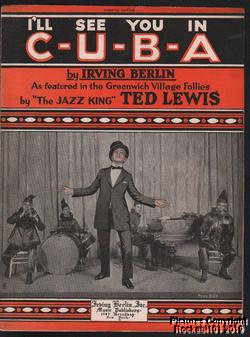 |
| 1920 Theater (Greenwich Village Follies) Sheet - I ll See You in C-U-B-A |

|
"I'll See You in C-U-B-A,"½ by Irving Berlin. Six pages front to back with a 1920 copyright. Published by Irving Berlin Inc, New York. Approximately 9 in. X 12 in. Cover art by Rose Studio shows a large center photo of singer Ted Lewis on stage with his band and the words, �As Featured in the Greenwich Village Follies by "The Jazz King", Ted Lewis. "The Greenwich Village Follies" was a musical revue that played for eight seasons in New York City from 1919 to 1927. Launched by John Murray Anderson, and opening on July 15, 1919, at the newly constructed Greenwich Village Theatre near Christopher Street, the show's success has been credited in part to its timing: as a non-union production, it was unaffected by the then-current actors' strike. Though considered a pioneer in the history of Off-Broadway musicals, this annual revue actually spent very little time in its original downtown home. The first edition moved uptown soon after its opening, as did the second. By the third year, the revue simply skipped its native venue and opened at the Shubert Theatre. Typically, after a run in New York, an adapted version of the show toured the country. Very good condition.
|
|
|
|

